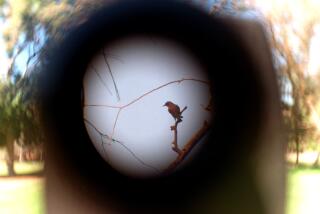Review: ‘Earthflight’ offers an astonishing bird’s-eye view
- Share via
“Earthflight,” which premieres Wednesday on PBS, is a six-part documentary about birds. As often happens with big nature films, it is a rebranded BBC production (nearly 2 years old), presented domestically under the flag of the series “Nature,” with rerecorded narration. Oddly, a two-hour version was broadcast here by Discovery Channel last October as “Winged Planet,” its title surely meant to evoke memories of Discovery’s earlier “Planet Earth” and “Frozen Planet” (also acquired from the BBC).
It will also evoke memories, should you have them, of “Winged Migration,” a 2001 Oscar-nominated French film in which, as in “Earthflight,” the camera seemed itself to become a bird among birds, flying side by side with geese and storks and pelicans through the use of ultralights, paragliders and radio-controlled drones. The new film uses all those tools, with an extra decade’s advances, and goes a step further by turning several of its avian subjects into recorders, strapping miniature high-def cameras to their backs for the closest thing yet to a bird’s-eye view.
It seems almost unnecessary to say that it is a beautiful and astonishing series, and to say as well that it is sometimes violent, nature being what it is. I am not ashamed to admit that I watch these documentaries with a finger on the fast-forward button. I know that it’s bird-eat-bird, but it doesn’t improve my life any to watch it happen. But that is just me.
INTERACTIVE: Fall 2013 TV preview
Fun facts: Birds navigate using the earth’s magnetic field and the position of the sun. But largely they just go by their eyes, looking out for landmarks. Scarlet macaws in the Amazon eat a special sort of mud to cure stomach aches they get from toxic jungle plants. Hummingbirds know how long it takes a flower to get its pollen back. Swallows return to the nest where they were born, passed down through the family sometimes for decades.
People and the things that people build (cities and farms and such) are sometimes the birds’ friends and sometimes not. (Chinese villagers revere swallows and swifts, welcoming them into their homes; German rooftops provide platforms for nesting storks; Manhattan skyscrapers provide helpful updrafts for tired migrating flocks; starlings love the heat of Rome.)
The episodes are divided by continent, more or less, with Australia and Asia combined and Antarctica absent. (It would be different if penguins could fly.) The final episode is a making-of documentary that reveals that some birds have been hand-raised to this particular job, to regard a (particular) human in an ultralight aircraft as a close relative.
So when migrating geese pass a picturesque paddle-wheel steamer on their way down the Mississippi flyway, that is not just a lucky accident; just so with a flyby of the Statue of Liberty and a flyover of Venice, a place they used to stop when it was marshland but now just looks great from the air. This might not be nature in its strictest sense, but if they are actors, they are also acting naturally.
There is, of course, artifice involved — editing, for instance, to make you feel that those monkeys and that baby bear were watching birds when they looked up. Sometimes what is meant to seem a birdcam is clearly the work of a drone (or helicopter). An especially cinematic image of grizzly bears and eagles gathering to score some salmon, looks like a crane shot (as in camera crane, not the bird) because it was, indeed, a crane shot. But most of it is just magic.
---------------------------
‘Earthflight, a Nature Special Presentation’
Where: KOCE
When: 8 p.m. Wednesday
Rating: TV-PG (may be unsuitable for young children)
More to Read
The complete guide to home viewing
Get Screen Gab for everything about the TV shows and streaming movies everyone’s talking about.
You may occasionally receive promotional content from the Los Angeles Times.







